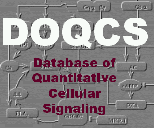| |
Reaction
Name | Pathway Name /
Pathway No. | Kf | Kb | Kd | tau | Reagents |
| 1 | cAMP-bind-site-A
1 | PKA
Pathway No. 135 | 75
(uM^-1 s^-1) | 110
(s^-1) | Kd(bf) = 1.4667(uM) | - | Substrate:
cAMP2.R2C2
cAMP
Products:
cAMP3.R2C2
|
| 2 | cAMP-bind-site-B
1 | PKA
Pathway No. 135 | 54
(uM^-1 s^-1) | 33
(s^-1) | Kd(bf) = 0.6111(uM) | - | Substrate:
R2C2
cAMP
Products:
cAMP.R2C2
|
| Hasler et al FASEB J 6:2734-2741 1992 say Kd =1e-7M for type II, 5.6e-8 M for type I. Take mean which comes to 2e-13 #/cell Smith et al PNAS USA 78:3 1591-1595 1981 have better data. First kf/kb=2.1e7/M = 3.5e-5 (#/cell). Ogreid and Doskeland Febs Lett 129:2 287-292 1981 have figs suggesting time course of complete assoc is < 1 min. | | 3 | cAMP-bind-site-B
2 | PKA
Pathway No. 135 | 54
(uM^-1 s^-1) | 33
(s^-1) | Kd(bf) = 0.6111(uM) | - | Substrate:
cAMP.R2C2
cAMP
Products:
cAMP2.R2C2
|
| For now let us set this to the same Km (1e-7M) as site B. This gives kf/kb = .7e-7M * 1e6 / (6e5^2) : 1/(6e5^2) = 2e-13:2.77e-12 Smith et al have better values. They say that this is cooperative, so the consts are now kf/kb =8.3e-4 | | 4 | cAMP-bind-site-A
2 | PKA
Pathway No. 135 | 75
(uM^-1 s^-1) | 32.5
(s^-1) | Kd(bf) = 0.4333(uM) | - | Substrate:
cAMP
cAMP3.R2C2
Products:
cAMP4.R2C2
|
| 5 | Release-C1 | PKA
Pathway No. 135 | 60
(s^-1) | 18
(uM^-1 s^-1) | Kd(cb) = 0.3(uM) | - | Substrate:
cAMP4.R2C2
Products:
PKA-active
cAMP4.R2C
|
| This has to be fast, as the activation of PKA by cAMP is also fast. kf was 10 | | 6 | Release-C2 | PKA
Pathway No. 135 | 60
(s^-1) | 18
(uM^-1 s^-1) | Kd(cb) = 0.3(uM) | - | Substrate:
cAMP4.R2C
Products:
PKA-active
cAMP4.R2
|
| 7 | inhib-PKA | PKA
Pathway No. 135 | 60
(uM^-1 s^-1) | 1
(s^-1) | Kd(bf) = 0.0167(uM) | - | Substrate:
PKA-active
PKA-inhibitor
Products:
inhibited-PKA
|
| This has to be set to zero for matching the expts in vitro. In vivo we need to consider the inhibition though. |
